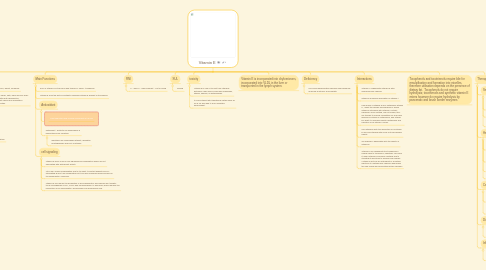
1. Found in...
1.1. Tocopherol - corn, wheat, soybeans
1.2. Tocotrienols - barley, oats, palm and rice bran - these have better anti inflammatory, antioxidant, anti cancer and cholesterol lowering properties.
1.3. almonds
1.4. olive oil
1.5. hazelnuts
1.6. avocado
1.7. sundried tomatoes
2. Deficiency
2.1. can cause degenerative diseases like Duchenne muscular dystrophy and infertility
3. Interactions
3.1. Vitarmin C regenerates vitamin E after quenching free radicals
3.2. vitamin E enhances absorption of vitamin A
3.3. High doses of vitamin E may antagonise vitamin K; whilst the precise mechanisms by which vitamin E interferes with vitamin K activity, especially blood clotting, are not known, they are thought to involve competition for enzymes involved in vitamin K metabolism, and vitamin E’s ability to increase hepatic metabolism and excretion of all vitamin K forms.
3.4. Iron interferes with the absorption of of vitamin E and can interfere with some of it biochemical effects.
3.5. Se deficeincy aggravates with the effects of vitamin E
3.6. Vitamin E can regenerate the tocopheroxyl radical back to tocopherol, effectively recycling it, when vitamin E becomes unstable due to donating its electrons to quench free radicals. (Vitamin E acts as an antioxidant by donating electrons to unstable free radicals (quenching the free radical and preventing further damage)
4. Contraindications
4.1. high doses may effect warfarin and aspirin
4.2. Raw kidney beans contain anti-vitamin E that produces necrosis of liver and muscular dystrophy
5. Main Functions
5.1. 90% of vitamin E in the blood and tissues is alpha - tocopherol
5.2. Vitamin E from the diet is constantly replacing Vitamin E present in the plasma
5.3. Antioxidant
5.3.1. Most important lipid-soluble antioxidant in the cell
5.3.2. antioxidant - protects cell membranes & lipoproteins from oxidation.
5.3.2.1. maintains cell membranes integrity, regulates prostaglandins and DNA synthesis.
5.4. cell signaling
5.4.1. Vitamin E plays a role in cell signalling and proliferation which are not associated with antioxidant activity.
5.4.2. Vit E may reduce inflammation due to it's ability to protect against ROS by stimulating B and t cell proliferation but it can also influence genes involved in the inflammatory response.
5.4.3. Vitamin E can reduce the production of pro-inflammatory eicosanoids as it inhibits the 5-Lipoxigenase (LOX), COX2 and Phospholipase A2 enzymes, which reduces the production of pro-inflammatory eicosanoids from arachidonic acid.
6. RNI
6.1. F - 3mg M - 4mg Pregnant - 3.8 to 8.5mg
7. SUL
7.1. 450mg
8. Theraputics
8.1. Sexual health
8.1.1. 400iu of vitamin E starting 2 days before the beginning of menstruation and continuing for 5 days, for two consecutive cycles significantly reduce pelvic pain dysmenorrhea
8.1.2. Vitamin A protects against testicular oxidative stress
8.1.3. Low serum Vit E levels is associated with elevated estrogen levels, and may negatively affect estrogen detoxification
8.2. Heart
8.2.1. Vit E protects LDL from oxidation and can decrease the cytotoxicity of oxidised LDL and decease arterial plaque formation
8.2.2. Vitamin E inhibits smooth muscle cell proliferation so helps to maintain normal endothelial function
8.2.3. Vitamin E inhibits smooth muscle cell proliferation & therefore maintains normal endothelial cell function
8.2.4. Vitamin E inhibits platelet adhesion & aggregation
8.3. Cancer
8.3.1. α-tocopherol succinate - shown to promote apoptosis of malignant cells to chemotherapeutic drugs, increasing the drugs’ effectiveness
8.3.2. tocopherol succinate, may be the most effective anti-cancer compound in the vitamin E family as it is not toxic to normal human cells and tissues.
8.4. Diabetes
8.4.1. Vitamin E has been shown in animal studies to increase glycaemic control, possibly by minimizing free radical damage.
8.5. Inflammation
8.5.1. Potent antioxidant - can also influence genes involved in the inflammatory response and can suppress the inflammatory transcription factor, Nuclear Factor kappa B
